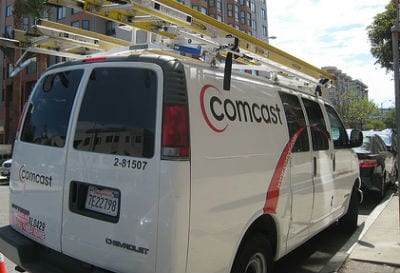When Comcast announced plans last June to halve its infamous four-hour installation window, it registered as big news — especially for a company long plagued by customer complaints about long wait times and suspect field service. After all, the company has been named one of the worst in the country in each of the past two years by The Consumerist.
 So while some customers remained skeptical about Comcast’s ability to improve on its public image by cutting its service window down to two hours, the initiative was generally hailed as step in the right direction for the one of the nation’s largest Internet and TV providers. (The company pledged to credit customers’ accounts $20 if service techs showed up late.) So, now over half a year later, how has successful has the initiative proved?
So while some customers remained skeptical about Comcast’s ability to improve on its public image by cutting its service window down to two hours, the initiative was generally hailed as step in the right direction for the one of the nation’s largest Internet and TV providers. (The company pledged to credit customers’ accounts $20 if service techs showed up late.) So, now over half a year later, how has successful has the initiative proved?
According to Comcast, so far, so good.
“We’ve seen an on-time arrival success rate of over 96 percent so far, with an end goal of 98 percent,” Rick Germano, Comcast’s senior vice president of global operations, told the SmartVan. “Costs have been flat for us and our customers are loving the shorter wait times so it’s really been a win-win situation.”
With nearly 40 million cable and Internet customers nationwide, those would seem to be successful metrics by any standards. So how has Comcast managed to make good on its promise? Germano said it’s a testament to the company’s willingness to adapt on the fly.

Rick Germano, senior VP of global operations for Comcast.
“Better tools, streamlining the process, moving customer education online, and working on scheduling files, quotas, and routing,” Germano said of the company’s approach to tackling the service window problem. “It’s partly a physics exercise, and a lot of the logistics reside in the scheduling file. We just plow through piles of data to figure the logistics out, then we learn as we go, tweak and build a system that makes it possible. It’s definitely possible. It’s not rocket science.”
Germano said the two-hour service window, which after initial tests in select markets has been fully implemented across the nation, has been possible largely due to restructuring on the dispatch end, rather than through technician training. Back-end logistics like drive-time, route-booking, expected time of visit, and allotted time for the job have all been analyzed for efficiency, leaving the techs with all the information and time they need to do their jobs. He also credits some old-fashioned hole-plugging.
“We’re running a lot of trucks every day of the year and the key is tightening all the little gaps,” Germano said. “It’s like traffic patterns. If every car has the exact perfect space between them and moves at the same time, there would be no slow-downs. We’ve had to do the same thing with our scheduling file and really close all the little holes of downtime.”
The company has also taken advantage of advancements in technology. As BusinessWeek reported last June, Comcast has begun phasing out its old rugged computer devices, and plans to equip all its techs with laptops and tablets. While the company is still in the testing phase of tablet deployment (only about 1 percent of its technicians have a tablet right now), the preliminary feedback has been encouraging.
“The tablets have been a home run,” Germano said. “We’ve run some pilot testing in some small groups, and the results were overwhelmingly positive. The techs loved it.”
Despite the massive dispatch operations overhaul and the implementation of brand-new mobile tools, the company says its operations costs rise by only 2 percent since last summer after an initial rise of 8 percent in the first few months. The company has not added personnel to its team of 32,000 technicians (10,000 of which are third-party, outside contractors), nor has it hired additional dispatchers to lighten the load. Germano admits the dispatchers have had to carry the extra stress of the big changes, “but once you get through the transition period, they understand that the process is working better and they’re happier.”
With Comcast’s early success halving its service window, will other companies follow suit? It’s not hard to imagine that other cable companies will soon feel pressure to improve their field performance as well — after all, field service techs are often the only in-the-flesh representatives of the company a customer ever sees, so the value of a positive interaction is incredible.
It seems that dreaded “We’ll be there between 9 and 5” could soon be a thing of the past.


The 2 hour gap time is great, but what about not being able to make an appointment for the same day. Its usually a couple day gap time between calling in and getting service. That is the real issue.